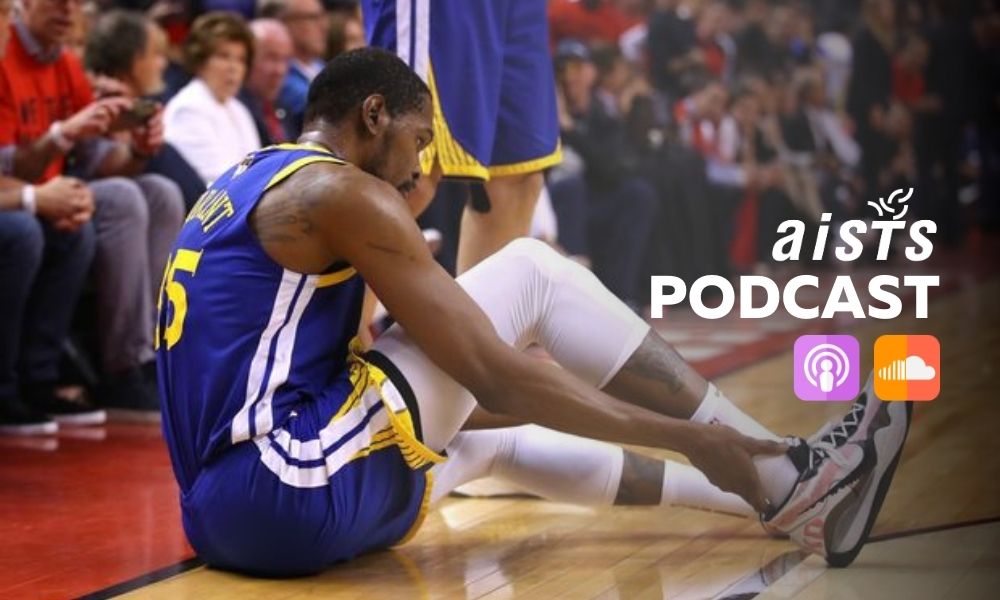
AISTS SPORT MEDICINE PODCAST #62
Basketball and ankle injuries: What’s going on?
Injuries to joints and ligaments are particularly common in professional basketball. Do players not allow the injuries to heal because the pressure to perform is too high, or is it due to the specific, explosive side-to-side movements? And: find out which foul play is said to have initiated a rule change in Basketball and what the (prominent!) athletes in question have to say about it. VIP alert!
This AISTS Sport Medicine podcast is created by AISTS Class of 2019 John VLAHOS, Aydin DIANAT under the supervision of Professor Boris Gojavonic, MD.
John: Welcome to our podcast, Boys and Girls. This is your favourite sports podcast host John Vlahos. In today’s episode, we’re talking about ankle injuries and basketball. We’re covering topics such as ankle injury prevalence within the sport of basketball, famous ankle injuries in the NBA, how these injuries have affected players and their teams, and were going to talk about how ankle injuries have shaped and changed the sport of basketball. Sitting to my left is the ever insightful, basketball aficionado Mr. Aydin Dianat. He’ll be chiming in during today’s podcast to provide some insight from his own illustrious career within the sport of basketball.
Aydin: Thank you for the warm introduction John. I’m very excited to be here with you today.
John: Today we’ll start with some basics to make sure that you non-doctors tuning in, including Aydin, can follow along. When it comes to the true ankle joint, there are three main bones. First you have the Tibia which forms the inside or medial portion of the ankle; the Fibula which forms the outside, or lateral portion of the ankle; and the Talus which is underneath these two bones and connect them to the rest of the foot. The true ankle joint is responsible for the up-and-down motion of the foot.
Aydin: Well, beneath the true ankle joint is the second part of the ankle, the subtalar joint, which consists of the talus on top and the calcaneus on the bottom. This joint is what allows side-to side motion of the foot.
John: An important aspect of the anatomy of the ankle is ligaments. What is important about ligaments is that they are connective tissues that connect bones to other bones to form joints. Their main physiological responsibility is to help provide stability to joints.
Aydin: These, along with the muscles and tendons of your lower leg, work together to handle the stress your ankle endures as you walk, run and jump. One of the most common ankle injuries in basketball is the ankle sprain which occurs when the strong ligaments that support the ankle stretch beyond their limits and in some cases, tear.
John: So why are ankle sprains common in Basketball? There are two main reason. First, basketball is a sport that involves explosive side-to-side movements and this increases the likelihood of twisting, inversion and eversion of the foot. Secondly, due to the amount of jumping in basketball, it’s not uncommon to land on an opponent’s foot. Aydin give us a specific example from the NBA.
Aydin: Kawhi Leonard injured his ankle twice in a game against the Golden State Warriors in the playoffs. First, he accidentally stepped on the foot of a teammate who was sitting on the bench and sprained his ankle. Team doctors quickly examined him and allowed him to continue playing in the same game. After returning, he landed on the foot of an opponent, Zaza Pachulia, and further injured the same ankle.
John: Returning to activity before the injured ligaments of the ankle have fully healed may cause them to heal in a stretched position, resulting in less stability of the ankle joint. Ankle sprains are classified on a scale of 1 to 3 depending on the amount of damage or the number of ligaments that are damaged. A grade 1 sprain is defined as mild damage to a ligament without instability of the affected joint. A grade 2 sprain is considered a partial tear to the ligament in which it is stretched to the point that it becomes loose. A grade 3 sprain is a complete tear of a ligament, causing instability in the affected joint.
Aydin: In professional basketball, a contributing factor to the increased risk of ankle sprains is returning to action too early. Players are under a lot of pressure to perform and it is not uncommon for them to return before they are ready or to play injured.
John: So, Aydin, how has the prevalence of ankle injuries in the NBA changed the game itself?
Aydin: Last season in the NBA, a rule change was introduced to address reckless closeouts. Reckless closeouts are when a defender advances toward a shooter trying to disrupt his shot. As a result of the rule change, referees can now judge if a defender’s foot placement was reckless. If they think this is the case they can punish the defender more severely with a flagrant foul.
John: This rule change was a direct result of the Kawhi Leonard that we spoke about earlier. Its actually called the ZAZA rule. Zaza stepped under Kawhi Leonard, causing his ankle injury. The goal of this rule is to stop defenders from stepping into a shooter’s landing space, a play that has resulted in many ankle injuries. Fortunately, today we have Zaza himself to talk more about this rule change.
John: Hello, Zaza and thanks for being on the show today. A lot of people are saying you intentionally put your foot directly under Kawhi Leonard so that he would get injured. Is that true?
Zaza: No chance. I respect Kawhi as a player and I’ve had injuries myself. I would never intentionally try to injure a fellow competitor.
John: How is this rule going to affect the way you play defence from now on?
Zaza: This rule won’t let me get as close to the players I’m defending and it’s going to be easier for them to take open shots. They’ll probably sink more baskets as a result.
John: Are offensive players doing anything differently now?
Zaza: These are smart guys and they are trying to draw more flagrant fouls by jumping forward when they shoot rather than going straight up and down. This increases their landing area and makes it even more difficult for defenders to guard them and block their shots.
John: Zaza, thanks for joining us but time to bring back today’s basketball expert Aydin to finish off today’s podcast.
John: Aydin, did you know that mild sprains can often be treated at home and will heal on their own. In addition to this mild exercise may help speed recovery after resting for a period of one or two days. Gentle exercise is good for blood flow and can help speed up the healing process.
Aydin: last season in the NBA, there were 112 ankle injuries between 75 players. Just to give you some perspective, there are only about 450 players in the entire league so that accounts about 15% of them!!!
John: 16% of these 75 players returned to play in the same game in which they injured their ankles.
Aydin: Let me go one step further. Last season the Atlanta Hawks had 11 separate ankle injuries in the 2017-2018 season between 7 different players. 4 of these 7 players missed the rest of the season following their ankle injury.
John: Well folks, unfortunately, we’re out of time and we’ll try to do better the next time. I’m John Vlahos
Aydin: I’m Aydin Dianat. Same time tomorrow, knuckleheads.
You can find more AISTS Sport Medicine podcasts on our Soundcloud channel or on the Apple Podcast app. To learn more about the AISTS Master of Advanced Studies in Sport Administration and Technology, visit https://aists.org/master-in-sport-management/
Recent articles





